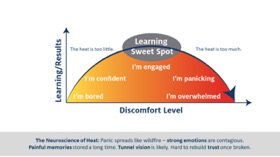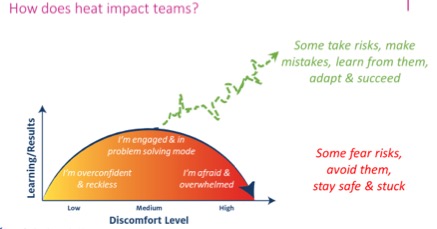I’ll never forget my first global assignment, leading disruptive change in a high-stakes environment. After one of the biggest promotions of my career, I quickly realized I was in over my head. We were transforming our global operating model spanning 100 offices. Despite working tirelessly, we kept hitting unexpected setbacks that frustrated everyone.
But right when tensions were highest, my boss suggested I team up with a mentor. This was a game-changer. I changed my mindset, began listening and delegating more, and found ways to reduce pain for key stakeholders. My team started feeling more empowered, and together we steered to success.
At the Center for Creative Leadership (CCL), we call situations like this “heat experiences.” They are high-stress, high-stakes situations that afford massive learning potential. Heat emerges when an organization is moving in a new strategic direction or grappling with disruptive change—like today’s Coronavirus—and the skills, systems, and culture are not aligned. The highest heat happens when teams tackle unfamiliar problems with unknown solutions.
The rewards of heat are often clear to executive teams pushing for faster and deeper change in order to stay competitive. Yet executives usually aren’t carefully considering the risks of heat, which include too much change simultaneously, fear of failure that spreads quickly and cements into a risk-averse culture, burnout, and turnover of top talent. The right kind of heat can accelerate growth at all levels, but the wrong kind can rage like wildfire.
How Workplace Heat Impacts Individuals and Teams
Heat comes in all shapes and sizes. However, its impact follows a predictable pattern for individuals, teams, and organizations.

When there isn’t enough heat, leaders and teams can become overconfident and lose focus. When there is too much heat, likely outcomes include burnout and the inability to learn. Frayed relationships, disillusionment, and feelings of resentment can emerge and turn into a powder keg. Explosive side effects such as tunnel vision, panic, and feelings of helplessness can compound.
Google researchers identified “psychological safety” as the most reliable predictor of team success. Without trust, progress halts. If people don’t feel secure enough to make mistakes or admit what they don’t know, they’ll more frequently choose a comfortable, self-serving path.
The primal brain is wired to handle fear and uncertainty, and when a threat is detected, your brain’s executive control center makes every decision in a desperate attempt to regain a sense of safety. When in survival mode, humans listen poorly, making collaboration suffer and stifling our ability to learn and adapt.
At CCL, we’ve found that heat can be positive when accompanied by “just-in-time” support. We’ve classified heat intolevels (low, medium, and high) and assigned best practice tiers of support (low, medium, high) to increase the chance of learning, not burnout.

Think about a time where you experienced high heat at work—maybe you’re struggling with it right now. What did you need most to make it through safely and learn from it? Was it the help of a coach, mentor, or supportive relationship that served as a safe sounding board to bring you back to a place of composure? Was it learning a powerful new way to debrief and coach others through the stress? Was it a training scenario that simulated similar heat? If provided at the right time, all of these can reduce the fear of future danger and build confidence to navigate future risks.
Tips for Trainers and Coaches
In most workplaces, heat goes unattended and undiscussed. If you are leading disruptive or unfamiliar change, heat surely will happen. The question is how to increase the chance of success through the ups and downs. Savvy coaches and trainers can follow these steps to help upskill their leaders and prepare teams to handle turbulence.
- For teams that matter most to the future of your organization, provide extra support on the verge of burnout. If you have a heroic culture, chances are people won’t tell you the amount of suffering they are really feeling. Observe carefully: Do people seem like they are constantly in fight-or-flight mode? Find a way to improve your debriefing process by offering a team coach or debriefing tools.
- Carefully assess where you want to turn up the heat to create readiness for the future. You can offer bigger stretch assignments to teams that succeed well together. Or you can simulate heat outside of work in safe-to-fail situations. We’ve thrown teams into new and wildly uncomfortable scenarios—from sailing to working with wild horses—to simulate how to handle unfamiliar, high-stress situations. If done properly, the results can improve collaboration methods when anxiety and fear levels are high.
- Remember that heat is deeply emotional, and practice empathy. We’re talking about the most challenging parts of someone’s career, the high-pressure moments they’ll likely remember for the rest of their lives. It can be taxing on their professional and personal wellbeing. Being empathetic can turn you from a potential threat into a safe sounding board. You may need to share stories of your own vulnerable and challenging heat experiences to make others feel safe to open up, as well.
- Customize your approach to the team’s specific needs and to your organization’s culture. There is no cookie-cutter solution. It will take careful discernment of whether people need encouragement or a bigger challenge to fuel their learning. It will be important to regularly reassess the team’s heat level to make sure you’re offering the right level of support, because it can change based on a variety of organizational and external factors.
Without proper support, I would’ve burned out in my role, and my team would’ve failed at our objective. There’s a chance leaders in your organization are on the verge of overheating and throwing in the towel, too. Yet with the right support, the potential for personal, team, and organizational growth is profound. In a complex business environment, that support can be the difference between organizations that flame out and those that burn brighter.
Chris Watz is a full-time faculty member at the Center for Creative Leadership. He is an expert in the field of program evaluation, maximizing return on investment of change initiatives, and leveraging strengths to enhance leadership impact.



